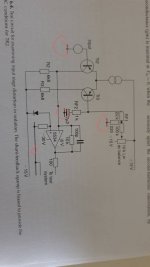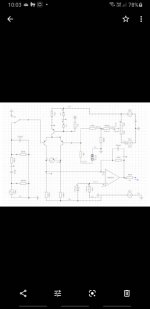Harkling back to the Otala/Lohstroh 1973 paper, which you have ibviously not read, they quoted authors who claimed that the transition from class A to class be shoud occur 17 dB below nominal power, to be on the safe side.
So bugger any X watts or Y watts, work it out. It's not as if one size fits all.
That's useful advice. Empirically we mostly guess that. I suspect that was by the average efficiency of the day? If we take this mythical 5 watts and say 20 db that is not bad. I suspect the 5 watts is more relevant?
I remember me quoting that to sound like a real voice on LS 3/5A 500 watts of transient power is required. This was to Robin Marshall. " That's absolute bo--ocks " said Robin. How come I asked? " Because I ( he ) said it " said Robin. For what it's worth I think we was right first time. Meridian 105 is my recommendation for them, Quad 405 seems good on paper. Not my choice. I dare say Hypex worth a try.
Nigel,
In a source follower stage the gate capacitance is to some extent cancelled out. This is explained by Cordell on page 7 here:
http://cordellaudio.com/papers/MOSFET_Power_Amp.pdf
I had guessed a bootstrapping effect as otherwise all my time at college taught me nothing and Mr Ohm and Xc = 1/2Pifc meant nothing also.
Bob I have to say for someone who has the ability to work through problems you make things very easy to understand. I now realize that people who give mysterious answers don't know any more than me. Bob you are a star. Tommy more so for understanding my question.
My own take on this is FET amps can slew less fast as they are intrinsically faster devices. Stop to think . When did you ever need more than 5 watts 20 kHz? Ask your tweeters the same question. They get nasty sun burn if you do.
Ben Duncan hints at this. He says he sees no reason why music demands high slew rates. However he has seen crossover distortion appearing up the waveform on amps with poor slewing when measured at HF. Me too. That is the loop is failing. Mr Self asks us to be careful when testing this way. Being that I mostly build FET amps I never was very cautious. Even with the Hitachi's low slews rate it never shows a problem.
To my ears turning the VAS current down to 5.6 mA was ideal for a single output pair. On scope less good on square waves but I think I saw better elsewhere. Could be it made driving the VAS easier by a tad?
Doug,
You claim that common mode distortion is non-problem in power amps already from very modest gain factors but in small signal audio with opamps in noninverting mode you think that it is serious problem that have to be solved even at the cost of more opamps used or additional transistors added. At which gain factor you would say that opamp in noninverting mode does not produce CM distortion? Could we say that RIAA circuit working with usual gain of 40dB does not produce CM distortion? I am asking this because recently I made some experiments with opams in inverting mode and noticed that the sound was subjectively considerably subjectively different (better).
You claim that common mode distortion is non-problem in power amps already from very modest gain factors but in small signal audio with opamps in noninverting mode you think that it is serious problem that have to be solved even at the cost of more opamps used or additional transistors added. At which gain factor you would say that opamp in noninverting mode does not produce CM distortion? Could we say that RIAA circuit working with usual gain of 40dB does not produce CM distortion? I am asking this because recently I made some experiments with opams in inverting mode and noticed that the sound was subjectively considerably subjectively different (better).
Hi Self:
Could you make a complete list based on all the wishes / inputs from this thread, maybe some of them are mentioned several times
I would also love to read more about:
a. "Practical designing amplfier - regards PCB layout - capacitors- inductors in copper traces / PCB material you need to take aware of.
b. Auto bias Circuit "virtuel class A, like Thule Audio"
c. "The principle behind "liniarize before feedback" example comparing a low feedback amplifier with high feedback amplifier.
d. Optimizing outputstage- reducing cross over distorting EF or CFP stage.
e. Designing High slewrate amplifiers using principle from (voltage-controlled current source or Operational
Transconductance Amplifier (OTA), like OPA 660)
f. Symmetrical designs - how to optimize inputstage for improved sound quaility after you have simulated a "perfect design" (VFA and CFA)
Could you make a complete list based on all the wishes / inputs from this thread, maybe some of them are mentioned several times
I would also love to read more about:
a. "Practical designing amplfier - regards PCB layout - capacitors- inductors in copper traces / PCB material you need to take aware of.
b. Auto bias Circuit "virtuel class A, like Thule Audio"
c. "The principle behind "liniarize before feedback" example comparing a low feedback amplifier with high feedback amplifier.
d. Optimizing outputstage- reducing cross over distorting EF or CFP stage.
e. Designing High slewrate amplifiers using principle from (voltage-controlled current source or Operational
Transconductance Amplifier (OTA), like OPA 660)
f. Symmetrical designs - how to optimize inputstage for improved sound quaility after you have simulated a "perfect design" (VFA and CFA)
Last edited:
Ten years after ... no, only after six of them, I have a question regarding the XD crossover displacement approach in EF vs. CFP output configurations:
XD loads one (e.g. the NPN-) half of the output transistors with an additional, modulated current, while leaving the other (e.g. the PNP) half unaffected. This drives both halves of the output section into an asymmetrical thermal dynamic behavior. And thus asymmetrically influencing the correct bias for best linearity, as there is an unequal thermal bias in both different Base-Emitter junctions of the power devices. So how can the correct bias be maintained within an EF topology along with an XD deplacer? Is it possible at all? I Imagine XD much more straightforward to implement within a CFP topology. And maybe XD ist only suitable within a CFP setup for best results?
XD loads one (e.g. the NPN-) half of the output transistors with an additional, modulated current, while leaving the other (e.g. the PNP) half unaffected. This drives both halves of the output section into an asymmetrical thermal dynamic behavior. And thus asymmetrically influencing the correct bias for best linearity, as there is an unequal thermal bias in both different Base-Emitter junctions of the power devices. So how can the correct bias be maintained within an EF topology along with an XD deplacer? Is it possible at all? I Imagine XD much more straightforward to implement within a CFP topology. And maybe XD ist only suitable within a CFP setup for best results?
Last edited:
Can you post a pic of this or a link to such a beast?XD loads one (e.g. the NPN-) half of the output transistors with an additional, modulated current, while leaving the other (e.g. the PNP) half unaffected. This drives both halves of the output section into an asymmetrical thermal dynamic behavior. And thus asymmetrically influencing the correct bias for best linearity, as there is an unequal thermal bias in both different Base-Emitter junctions of the power devices.
Can you post a pic of this or a link to such a beast?
Hi Richard
I haven't seen you post in DIYaudio for a while, wondered what had happened to you, no answer to my emails so I hope you are OK.
If you are still interested I have a new circuit that you may like.
Lower distortion than XD and a lot more efficient.
Don't want to hijack Mr Self's thread so link is here Very Efficient Very Low Distortion Linear+ Amp
Best wishes
David
Hi All,
I'm interested in building the IPS test circuit shown in Douglas's book.
I'm just checking it out in a simulator first and just wanted to confirm that the circled points are indeed ground.
I plan to test and build a few inputs stages and test their distortion levels with my QA401.
Cheers
Stuart.


I'm interested in building the IPS test circuit shown in Douglas's book.
I'm just checking it out in a simulator first and just wanted to confirm that the circled points are indeed ground.
I plan to test and build a few inputs stages and test their distortion levels with my QA401.
Cheers
Stuart.


- Status
- This old topic is closed. If you want to reopen this topic, contact a moderator using the "Report Post" button.
- Home
- Amplifiers
- Solid State
- Audio Power Amplifier Design book- Douglas Self wants your opinions